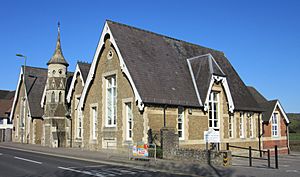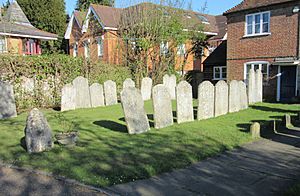Meadrow Unitarian Chapel facts for kids
Quick facts for kids Meadrow Unitarian Chapel |
|||||||||||||||||||||||||||||||||||||||||||
|---|---|---|---|---|---|---|---|---|---|---|---|---|---|---|---|---|---|---|---|---|---|---|---|---|---|---|---|---|---|---|---|---|---|---|---|---|---|---|---|---|---|---|---|
| Godalming Unitarian Church | |||||||||||||||||||||||||||||||||||||||||||

The chapel from the northwest
|
|||||||||||||||||||||||||||||||||||||||||||
|
|||||||||||||||||||||||||||||||||||||||||||
Meadrow Unitarian Chapel is a special church in Farncombe, a part of Godalming, Surrey, England. It is also known as Meadrow Chapel or Godalming Unitarian Church. This chapel belongs to the Unitarian faith. It is part of a larger group of Unitarian churches in Britain.
The chapel started in 1789 as a General Baptist church. Godalming was a town where many people did not follow the main Church of England. They were called Nonconformists. The chapel's beliefs changed over time. By the 1800s, it became a Unitarian church. For many years, services were held in a different building nearby. But in the mid-1970s, the original chapel was used for worship again. This old chapel is important for its history and design. It is protected as a Grade II listed building.
Contents
History of Meadrow Chapel
Early Beginnings: Nonconformists in Godalming
Godalming was a town known for its small factories. Many workers in the 1600s, 1700s, and 1800s were Nonconformists. This meant they were Protestants who did not belong to the Church of England. In the late 1600s, over 1,000 of Godalming's 3,000 residents were Nonconformists. They met in private homes because there were no special churches for them yet.
One of the biggest Nonconformist groups in Surrey was the Baptists. Over time, some Baptist groups changed their beliefs. They moved towards Unitarianism. Unitarianism is a Christian faith that does not believe in the Trinity (God as Father, Son, and Holy Spirit).
From Baptist Meetings to a New Chapel
Baptist meetings had a long history in Godalming. Small groups met in different places from the 1600s. A preacher named Matthew Caffyn often visited and helped these groups. By the late 1700s, many meetings took place at William Evershed's house. He lived near Godalming. Evershed also helped start a Baptist chapel in Billingshurst in 1754. That chapel also became Unitarian later.
In the late 1700s, the group meeting at Evershed's house decided to build their own church. In 1783, they agreed to build a meeting house at Meadrow in Godalming. The chapel was built and opened in 1789. It was a simple, nice building. It had a special pool called a baptistery for baptisms. The first baptism there was in 1809.
The church slowly changed its beliefs. It became fully Unitarian in the second half of the 1800s. Another small group of Unitarian Baptists in Godalming later joined this chapel.
In 1821, a brick cottage was added to the chapel. In 1870, a Sunday school building was built closer to the road. This new building was later used as the main chapel. The original 1789 building then became the Sunday school. This changed back in 1975 or 1976. The 1870 building became the schoolroom again. Worship returned to the older, original chapel.
The church also helped start a free school for all children. This was common for Nonconformist churches in the Victorian era. They cared a lot about helping people. A new school building was built in 1872 on Bridge Road. It was made bigger around 1900. This school building is also now a Grade II listed building.
After the church moved back into the original chapel, it was allowed to hold weddings in June 1976. It is also officially registered for worship.
Chapel Architecture and Design
The Meadrow Unitarian Chapel was made a Grade II listed building on May 16, 1975. This means it is important to the country and has special historical or architectural value. In February 2001, it was one of many listed buildings in the area. Godalming has several other churches with listed status.
The chapel is a one-story building. It is made of red-brown bricks. The attached cottage next to it also shows the brickwork. But the chapel itself is covered with a smooth plaster called stucco. The cottage has two stories but is the same height as the chapel. They share a tiled roof.
The front of the chapel has four sections. The cottage makes up the left-most section. There is a porch in the middle with a pointed roof. There are chimneys on the roof. The chapel and cottage are separated by special corner stones called quoins. A decorative border, called a cornice, runs along the top of the front wall.
The chapel has three arched windows. Two windows to the right of the porch are tall. The third window, between the cottage and the porch, only lights the top part of the chapel. There is a door below this window. Another door leads into the cottage. The chapel's porch has a round arch and a cross on its roof. At the back of the chapel, facing the River Wey, there are three more arched windows.
Inside, the old wooden benches have been moved to the walls. This creates an open space for worship. Above one part of the chapel, there is a wooden balcony supported by columns. The chapel measures about 35.5 feet (10.8 meters) long and 22 feet (6.7 meters) wide. The baptistery, a pool for baptisms, is still there in the floor. It has brick steps leading down into it.
Burial Ground at the Chapel
The last person was buried at the chapel in 1869. Ten years later, someone wrote down all the names and dates from the gravestones.
There are four special burial vaults in front of the chapel. These are like underground rooms for burials. They hold members of the Elphs, Pilsley, Ellis, and Knight families. John Ellis was a big helper in building the chapel.
In total, 46 people are buried in the chapel's burial ground. There are rows of graves on both sides of the path to the chapel. Some graves are even under the path itself. Many people with the last name Ellis are buried here. In one row, seven graves belong to people named Cooke.
See also




